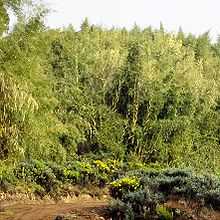Yushania alpina
From Wikipedia, the free encyclopedia
| Yushania alpina | |
|---|---|
 | |
| Bamboo on Mount Kenya | |
| Scientific classification | |
| Kingdom: | Plantae |
| (unranked): | Angiosperms |
| (unranked): | Monocots |
| (unranked): | Commelinids |
| Order: | Poales |
| Family: | Poaceae |
| Subfamily: | Bambusoideae |
| Supertribe: | Bambusodae |
| Tribe: | Bambuseae |
| Subtribe: | Arundinariinae |
| Genus: | Yushania |
| Species: | Y. alpina |
| Binomial name | |
| Yushania alpina (K. Schum.) W.C.Lin (1974) | |
 | |
| Native range of Yushania alpina | |
| Synonyms | |
|
Arundinaria alpina K. Schum.[1] | |
Yushania alpina or African alpine bamboo, a perennial[3] bamboo of the family Poaceae and the genus Yushania[1][4] or the genus Sinarundinaria[2][5] but not of the genus Chimonocalamus[6] that can be found growing in dense but not large stands[7] on the mountains and volcanoes surrounding the East African Rift[1] between the altitudes of 2,500 meters (8,200 feet)[7] and 3,300 meters (11,000 feet).[8]
Description
- Stems and leaves
- 200 - 1,950 centimeters (6 – 64 feet) tall and 5 - 125 centimeters (2 - 50 inches) in diameter;[3] these grass stems get used as fencing,[7] plumbing and other building materials.[9] Culm sheaths (tubular coverings) are hairless or with red bristles.[3]
- Leaf sheath is covered with bristles. Leaf blades are "deciduous at the ligule"; blades 5 - 20 centimeters (2 - 8 inches) long.[3]
- Flowers
- Branched cluster of flowers in solitary spikes which can be dense or loose and are 5 - 15 centimeters (2 - 6 inches) long.[3]
- Roots
- Short rhizomes described as pachymorph[3] (a term which is recommended for describing rhizomes which are sympodial or superposed in such a way as to imitate a simple axis, but the word pachymorph would not be used for describing branches or in the case of bamboos, culms).[10]
Distribution
- Native
- Afrotropic:
References
- ↑ 1.0 1.1 1.2 1.3 Germplasm Resources Information Network (GRIN) (2004-03-17). "Taxon: Yushania alpina". Taxonomy for Plants. USDA, ARS, National Genetic Resources Program, National Germplasm Resources Laboratory, Beltsville, Maryland. Retrieved 2008-05-08.
- ↑ 2.0 2.1 "Sinarundinaria alpina (K.Schum.) C.S.Chao & Renvoize record n° 54488". African Plants Database. South African National Biodiversity Institute, the Conservatoire et Jardin botaniques de la Ville de Genève and Tela Botanica. Retrieved 2008-05-08.
- ↑ 3.0 3.1 3.2 3.3 3.4 3.5 Royal Botanic Gardens, Kew. "RBG Kew: GrassBase - Yushania alpina". GrassBase - The Online World Grass Flora. Board of Trustees of the Royal Botanic Gardens, Kew. Retrieved 2008-05-08.
- ↑ International Organization for Plant Information (IOPI). "Yushania alpina". International Plant Names Index. Retrieved 2008-05-08.
- ↑ International Organization for Plant Information (IOPI). "Sinarundinaria alpina". International Plant Names Index. Retrieved 2008-05-08.
- ↑ International Organization for Plant Information (IOPI). "Plant Name Search Results". International Plant Names Index. Retrieved 2008-05-08.
- ↑ 7.0 7.1 7.2 Gerold, Gerhard; Michael Fremerey, Edi Guhardja (2004). "Rain Forest Margins and their Dynamics in South-East Ethiopia". Land Use, Nature Conservation and the Stability of Rainforest Margins in Southeast Asia. Springer Science+Business Media. ISBN 3-540-00603-6.
- ↑ H. Peter Linder and Berit Gehrke (2 March 2006). "Common plants of the Rwenzori, particularly the upper zones" (PDF). Institute for Systematic Botany, University of Zurich. Archived from the original on 2008-05-30. Retrieved 2008-05-06.
- ↑ International Network for Bamboo and Rattan (INBAR) (May 2005). "Country Report on Bamboo Resources Ethiopia". Global Forest Resources Assessment (Food and Agriculture Organization of the United Nations). Retrieved 2008-05-08.
- ↑ Stapleton, Chris (1998). "Form and Function in the Bamboo Rhizome". Journal of the American Bamboo Society 12 (1). Retrieved 2008-05-08.
This article is issued from Wikipedia. The text is available under the Creative Commons Attribution/Share Alike; additional terms may apply for the media files.